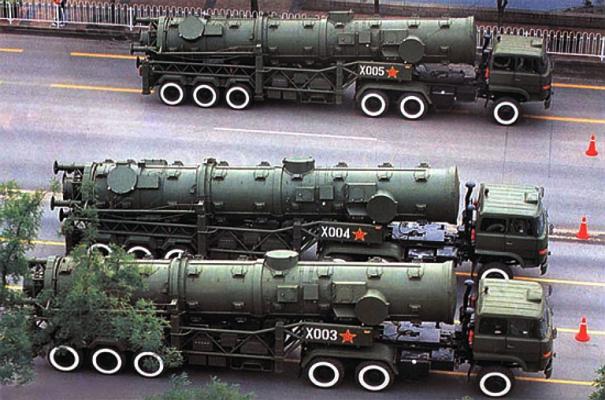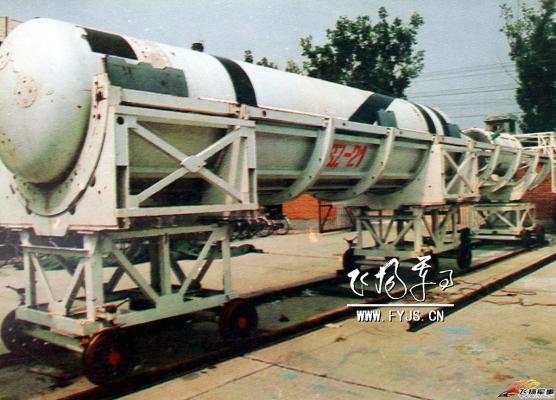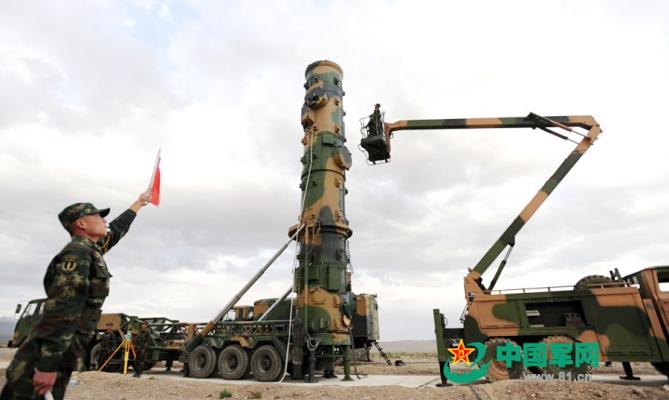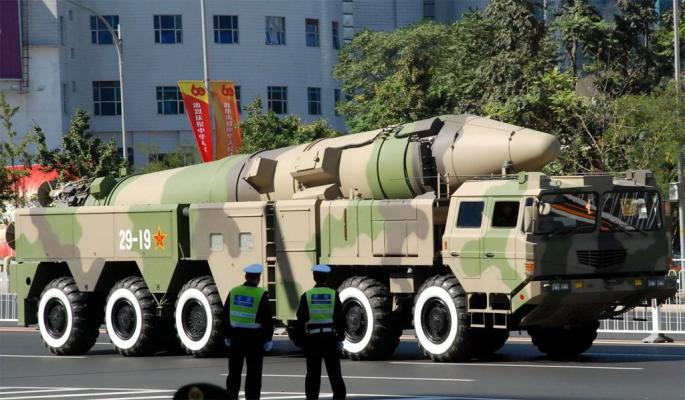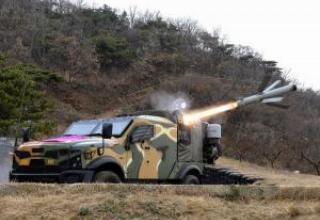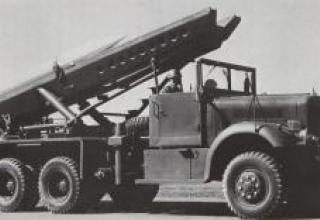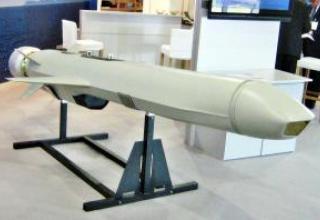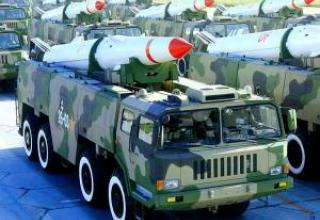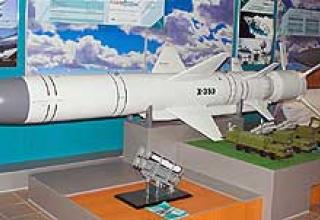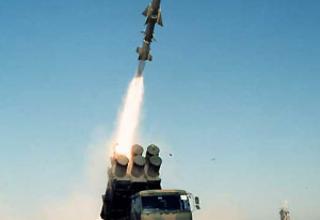The DF-21 (Dong Feng-21) medium-range mobile missile system is designed to strike the enemy's administrative and political centers, control centers and small area targets: airfields, seaports, power plants, oil and gas terminals.
The main developer of the Df-21 complex is the Second Aerospace Academy of China, now China Changfeng Mechanics and Electronics Technology Academy (CCMETA). CCMETA is part of China Aerospace Science & Industry Corporation.
The DF-21 program at the Second Aerospace Academy has been in operation since 1976 and has been parallel to the development of the first solid-fuel submarine missile, the Juilan-1 (JL-1). The DF-21 missile was originally designed as a nuclear weapon carrier and its design made extensive use of the JL-1 hull and engine developments. The chief designer of both programs was Juan Vailu.
On May 20, 1985, the first successful flight test of the DF-21 was conducted at the 25th rocket base (Ujai). Two years later, in May 1987, a second flight test was conducted there. In 1988, the DF-21 was successfully completed, but no decision was made to put it into service.
In 1986, in parallel with the tests, work was started to create an upgraded version of the DF-21A, the main feature of which was an extended range. After a number of failures, the first successful flight test of the DF-21A took place in January 1995 at a 25-rocket base. This was followed by successful launches in August and November 1995, and in 1996 the initial operational readiness of the DF-21A was achieved and it was adopted for service by the Second Artillery Corps of PLA.
Later the complex was repeatedly upgraded and served as a basis for the development of new weapons. In addition to the D-21A, the following modifications of the DF-21B, DF-21C and DF-21D are known. The last modification, DF-21D, is currently the only anti-ship ballistic missile in the world.
On July 23, 2002, China, according to official representatives of U.S. intelligence, conducted flight tests of DF-21 ballistic missile equipped with a missile defense breakout system. U.S. intelligence satellites tracked the missile's flight from the start to the fall in western China. The range of the flight was about 2010km. Made from the satellite photos of the fall area allowed to conclude that the missile carried six or seven false targets of the missile defense breakout system.
DF-21 missile was used during tests of the Chinese anti-satellite weapons system. Thus, on 11.01.2007 the mass media reported on successful testing of this system: the upgraded DF-21 missile (possibly designated SC-19) successfully injected into a low Earth orbit the KKV kinetic interceptor, which successfully struck the Chinese weather satellite Fengyun 1C (FY-1C), which was put out of service. It was launched from the Xichang Satellite Launch Centre. The target was intercepted at an altitude of 537 km above the central regions of China on a counter course at 8 km/s. Earlier, U.S. intelligence reported on two SC-19 DA-ASAR flight tests in 2005 and 2006, during which no relay target interception was performed.
It is estimated that PLAAF has up to 100 DF-21 missiles deployed in Liaoning, Jiangxi, Yunnan, Fujian, Qinghai provinces. The position areas of DF-21D anti-ship missiles in the Changbaishan Mountains enable PLA to control the straits connecting the Sea of Japan with the world's oceans. The U.S. Naval Base on the island of Guam is also in the area of destruction.
In 2014 the information on deliveries of DF-21C complexes to Saudi Arabia was published.
Composition:
DF-21A/B (CSS-5 Mod1/2)
The DF-21 is a two-stage solid propellant rocket with a detachable head end (MS). The engines are equipped with charges of mixed fuel based on polybutadiene with hydroxyl-terminated polybutadiene end groups.
The DF-21A rocket is equipped with an inertial control system with a digital computing complex providing a circular probable deviation (RVD) of 300-400m. Further control system improvement allowed to reduce CVO to 100-300m for DF-21B.
The weight of the missile head part is 600 kg. As a warhead, the DF-21A can carry a monoblock nuclear charge of up to 500 kg or be equipped with various types of non-nuclear warheads. Information on the presence of fragmentation, chemical and cassette warheads has been published.
Launching unit (PU) of DF-21A complex is located on the HY4260S road train with the payload capacity of 26.5 t and towed by the HY-472 tractor (see photo1, photo2, photo3, photo4). Tractor HY-472 with 6x6 wheel configuration is equipped with a V-shaped 12-cylinder diesel engine BF12L413F with an output of 325KW at 2500 rpm.
Dimensions of the semitrailer HY4260S - 7460h2580h3050m, weight - 11.5 t. On the semitrailer there is a transport and launch container (TPC) with a rocket, starting equipment, lifting and fixing mechanisms. Diameter TPK-2m.
In the combat position the TPK rests on four hydraulic jacks, which provide verticalization of the container before launch. The semitrailer is additionally equipped with six jacks to unload the running gear and ensure the stability of the PU during the launch of the missile. Preparation time for launch is 10-15 minutes. Launch of the rocket - mortar (see photo), is carried out directly from the transport and launch container with the help of special PAD, placed on the bottom of the TIC. The first stage marching engine is switched on after the rocket leaves the container.
The DF-21A battery includes three launchers, a command post, a power supply vehicle, technical and launch position ground equipment vehicles (6 pcs.).
The disadvantages of the DF-21A include: its considerable weight and insufficient mobility. On combat duty, the DF-21A complexes are located in stationary shelters (including rock tunnels) and secretly move between them. According to the published information, the combat application is assumed from the shelters and from the previously prepared patrol route points.
DF-21C (CSS-5 Mod3)
A radically improved complex of the DF-21 family, designated DF-21C, was first demonstrated in 2006. (see photo1, photo2, photo3, photo4, photo5, photo6, photo7).
The main difference of the new variant was the location of the launcher and auxiliary equipment on one chassis of the WS2500 with the wheel arrangement 10x10 and payload capacity of 28 tons. DF-21C has more mobility and secrecy, can move on general purpose roads.
DF-21C rocket is equipped with a new inertial control system and is combined with the national satellite navigation system BeiDou, which allowed to increase the accuracy of guidance up to 30-40m KVO. The weight of the head unit is -2000 kg, maximum firing range is 1700 km.
The missile's flight control during the first stage engine operation seems to be carried out by deflecting the engine nozzles, during the second stage engine operation - by injecting gas into the critical part of the nozzle. Separation of stages is provided by opening the counter-retraction nozzles in the front part of the first stage.
The nuclear version of the head end is equipped with three small-size 90Kt combat units and a missile defense breakthrough complex with a set of heavy and light decoys.
The non-nuclear version of the missile can carry various types of combat units, including electromagnetic ballistic missiles, which provide failure of electronic equipment, detection and communication systems of the enemy. For flight control and anti-missile maneuver on the final section of the trajectory at atmospheric entry, the DF-21C head unit is equipped with aerodynamic rudders.
DF-21D (CSS-5 Mod4)
The DF-21D is the only anti-ship ballistic missile designed to destroy aircraft carrier strike teams at long range.
Initial data for firing can be provided by satellite or airborne target designation systems, over-the-horizon radars.
In the descending section of the trajectory, after the head end, its flight speed reaches 10M. Guidance in the passive section is provided by radar CNS, with signal processing by the onboard digital computer system. Judging by the published information, this section is controlled by aerodynamic rudders on the head end and a gas-jet correction unit.
It is difficult to judge the technical perfection of the homing system and combat efficiency of the DF-21D due to the obvious lack of information. However, it can be assumed that the DF-21D's short flight time (about 12 min.), high flight speed and large dive angles to the target, detachable head end make the task of intercepting the DF-21D difficult using any of the existing missile defense technologies.
The R-27K missile for a similar purpose, developed in the USSR in 1974, was never adopted for service.
Characteristics:
| DF-21A | DF-21C | DF-21D | |
| Range of fire, km: - minimum - maximum |
500 2700 |
500 1700 |
100 1450 |
| Starter weight,kg | 14700 | ||
| Dimensions, m: - length - diameter |
10.7 1.4 |
||
| Weight of the first stage, kg | 7800 | ||
| Weight of combat unit, kg | 600 | 2000 | 2000 |
| KVO, m | 100-300 | 30-40 | 30 |
| Pre-start preparation time, min. | 10-15 | 9-10 | 9-10 |
Testing:
29.07.2004 First tests of Arrow-2 system off the coast of California. The anti-missile successfully hit a target simulating a "Scud" missile at an altitude of 40 km.
26.08.2004 Arrow-2 system failed tests off the coast of California. The anti-missile failed to intercept a target fired from an aircraft simulating an advanced Scud-D missile. During the tests, the detection radar successfully detected and identified the target. Problems arose during the final phase of the interceptor flight, after the first stage separation.
On 02.12.2005, the missile defense battery deployed at Palmahim Air Base successfully intercepted a target simulating the operational-tactical missile "Shihab-3". In the tests, an upgraded version of the Arrow-2 block 3 anti-missile was used, which has enhanced tactical and technical data, including for actions against group targets.
11.02.2007 First night launch of the Arrow-2 anti-missile. Two geographically dispersed batteries of the Israeli ABM system were used in the tests. The interception was provided by a battery located at a greater distance from the launch site of a target launched from an Israeli Air Force F-15 fighter.
26.03.2007 Successful testing of the improved Arrow-2 rocket in conjunction with other systems of the complex. New interceptor has modernized control system and longer range.
16.04.2008 Successful launch of the new Arrow-2 block 3 missile modification on the target simulating Shahab-3 ballistic missile launched from F-15 fighter. During the tests in test mode for the first time the improved EL/M-2080S Super Green Pine detection radar was used.
07.04.2009 Successful test of the Arrow-2 block 4 missile. Ankor Cahol (Blue Sparrow) target launched by Israeli Air Force F-15 fighter from a distance of about 1000 km was intercepted over the Mediterranean Sea. The EL/M-2080 Green Pine radar and the American forward-based mobile radar (FBX-T) AN/TPY-2, deployed in the Negev in late 2008, took part in the test.
On 27.07.2010 the USA and Israel concluded an agreement on joint development of a new Arrow-3 missile system. According to the document, Israel will receive $100 million from the United States to work on this BMD system.
On 22.02.2011 the USA and Israel jointly tested the upgraded Arrow-2 anti-missile. The missile was launched on the California coast and was considered successful - the missile hit a ballistic target launched from a U.S. Navy ship. This test was the second one in which the full Arrow BMD system, including the EL/M-2080 Green Pine radar, took part.
29.07.2011 Successful first test of the Arrow-3 anti-missile system. The missile successfully hit the conventional enemy's ballistic target missile.
10.02.2012 Testing of the Arrow-2 block 4 anti-missile, as part of the complex. Detection and tracking of the target launched from an Israeli Air Force fighter was performed for the first time using the EL/M-2080S Super Green Pine radar. After the information was transmitted to the Citron Tree combat control system, an intercept team was formed and no actual missile launch was conducted.
25.02.2013 Israel Defense Ministry announced a successful flight test of the Arrow-3 complex over the Mediterranean Sea. The interceptor reached a flight altitude of 100km, the flight lasted 6 minutes.
03.09.2013 Israel Missile Defense Organization and the U.S. Missile Defense Agency (U.S.) announced the first flight test of a new target "Ankor Shahor" ("Black Sparrow"). The test was conducted at an Israeli test site in the Mediterranean Sea. The targets were launched at 9:15 a.m. The test was conducted at the Israeli test site in the Mediterranean Sea. The radar Super Green Pine of Arrow complex detected the target and provided escort, the information received was transmitted to the combat control system Citron Tree. According to the Israeli Defense Ministry, all elements of the missile defense system worked out as usual.
The Russian Defense Ministry said that the radar station of the Russian missile warning system, located in Armavir, detected the launch of two ballistic missiles from the Mediterranean Sea towards Syria. According to the Russian side, both objects fell into the sea.
09.09.2014 Testing of the Arrow-2 ABM system to intercept the Ankor Shahor target (see photo). Interception failed.
03.01.2014 According to the press-service of the Ministry of Defence, the second test of the Arrow-3 ABM system took place at the Palmakhim airbase. At 08:00, the Arrow-3 missile interceptor successfully entered the calculated flight path in the upper atmosphere, in accordance with the test plan. All systems worked out in the normal mode.
09.09.2014 The Israel Defense Ministry announced that the advanced Arrow-2 ABM system had been tested. The purpose of the tests, conducted with the assistance of the Pentagon, was to test the effectiveness of the new version of the system against future potential threats. Later on the Israeli media published information that the tests failed.
16.12.2014 Failed tests of the Arrow-3 anti-missile. The Israeli Defense Ministry reports that problems occurred during the launch of the missile.
10.12.2015 The Israel Defense Ministry reported the successful test of the Arrow-3 BMD system (see photo). The interceptor missile was launched at 8:10 local time and successfully intercepted the target outside the atmosphere. It was launched from the Palmachim military base at the Anchor Shahor target fired by an Air Force aircraft over the Mediterranean Sea.
